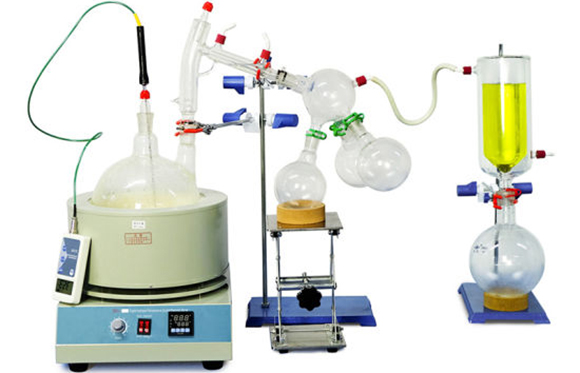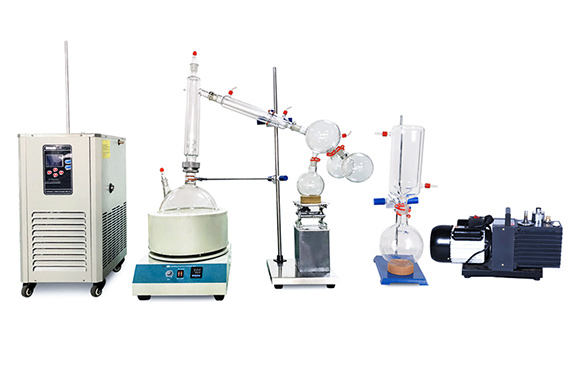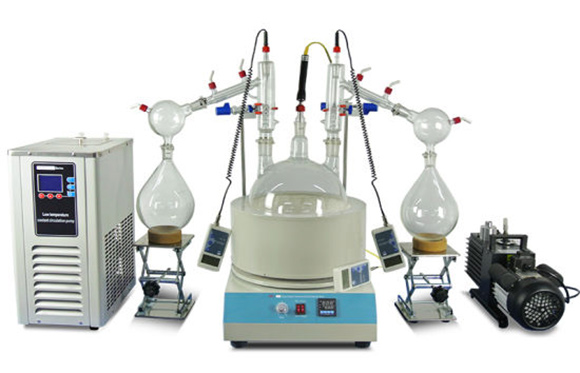News
Short path distillation industrial equipment list
The short-path distillation equipment list produced by our company has the following four models.
 |
 |
| SPD-2L short-path distillation | SPD-5L short-path distillation |
 |
 |
| SPD-10L short-path distillation | SPD-20L short-path distillation |
Short Path Distillation Quick Start Guide
Before starting the distillation, make sure you have taken the following steps:
1.The vacuum pump is in good working condition. The pump should be operated under dry load to preheat the internal components. The oil should be clear. Cloudy or black oil should be changed.
2.All glass components are in good working condition and ready to be assembled
3.Winterization and degassing procedures have been carried out to prepare oils for distillation
Once you have completed all three steps, you are ready to start refining.
1.The stir bar was first placed in a boiling flask and the material was loaded. This should be done using a funnel. A small amount of alcohol in the oil will make it lower in concentration and easier to transfer.
2.Assemble all glassware and ensure that each joint is coated with the appropriate grease. Do not use too much, as vacuum pressure may draw some grease into the system. To ensure complete sealing, apply grease circumferentially by rotating the glassware
3.The circulator was connected to the condenser and the temperature was set to 50 °C. Allow the circulator to reach temperature before starting distillation.
4.Connect the vacuum pump to the manifold. The manifold will allow you to isolate each individual component and allow the atmosphere to enter and exit the system.
5.Connect the receiving cattle to the cold trap.
6.Connect the cold trap to the manifold.
7.Connect the vacuum gauge to the manifold.
8.At this point, make sure all connections are correct. Also make sure that the location of the receiving cow can collect the first part of the leftmost receiving bottle. The circulator should be at its set temperature. Turn on the vacuum pump and start processing.
9.Turn on the heat and set to 60 °C. The vacuum pump will start to drop and the temperature will start to rise. The instrumentation monitors vacuum pressure and stability.
10.Start stirring slowly and increase with temperature.
11.Once approaching 60C, the temperature is increased by 20 degrees. Continue to increase the heat in steps of 20 degrees and increase the set temperature as it approaches the set point. Gradually increase the temperature until it reaches 220 °C.
12.You will see your first score between 180C and 190C or before. This is the "head" part.
13.When you see an increase in head reaction, a slight yellowing of the color, and a thickening of the distillate, you move to the second part. When the fraction collides, let the distillate "self-clean" the head for a minute or two and then rotate the cow to the middle receiving flask. Collect your 14."subject" section. During this score you will see the temperature between 190-220C.
15.Continue to increase the stirring speed if necessary. The reaction of the head may vary, but it should never stop. As the liquid level in the boiling flask decreases, the stirring speed is increased.
16.The final "tail" portion is a mixture of the first and second portions that should be stored for later distillation. Ideally, you want to turn the cow into the final flask before the number of tails is reached. The "tail" portion has a distinct color change and is darker than the "body" portion. During this 17.score you will see temperatures between 200-250C.
As the level in the boiling flask was further reduced, the agitation RPM was set higher (1000 + RPM). You may need to add more calories to complete the final fraction.
Once the process is complete, stop heating, stop stirring, and stop the vacuum. Let the atmosphere enter the system. Make sure the distillate is properly stored in the air and the light will cause oxidation.
Features of short path distillation:
- High quality and heavy duty Borosilicate 3.3 glass for durability.
- Vacuum-jacketed distillation adapter, with 4 Vigreux stages.
- 2L heating mantle with magnetic stirring function.available in 220V.
- Detachable plastic 3/8”(10mm) hose barbs for maximized safety during operation.
- Carefully designed 3-way cow adapter accommodates up to 3 pcs of 500mL flasks.
- The cold trap protects the vacuum pump from contamination and damage of vapors.
- Flexible choice of vacuum pumps and heater/chillers.
Send Us Message
Your message was sent successfully.
Sorry!Something Went Wrong.
